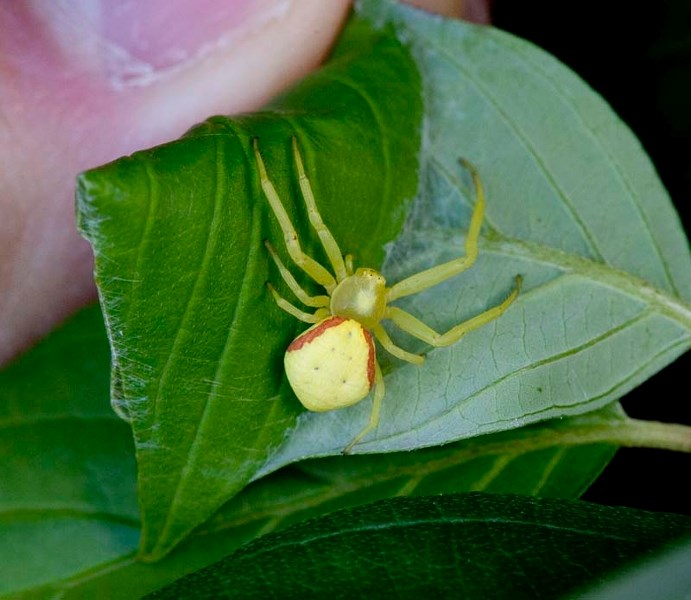Spiders have a way of sneaking up on you.
Spiders have a way of sneaking up on you.
I was recently perusing some flowery bushes down at the botanic garden, for example, taking in all the shiny, emerald leaves when bam! Big yellow spider, arms outstretched for a big, lethal hug!
“Hello spider,” I said.
“…,” it replied, as it shyly slunk beneath its leaf.
The spider in question was a goldenrod crab spider – quite likely the spider most likely to spook you when you're sniffing the flowers. Masters of disguise, these little fellows are often impossible to see unless you're almost nose-to-nose with them – at which point you're probably dead if you're a bug.
Also known as flower crab spiders, goldenrod spiders have short, flat, wide bodies less than a centimetre long and a pair of long front legs that they hold out to their sides like a crab's claws, reports the Canadian Wildlife Federation. They are often found in gardens camped out upon yellow or white flowers.
You can find these critters throughout the Arctic Circle, says Edmonton arachnologist Robin Leech – from Sweden to North America.
“There aren't that many organisms that have such a wide distribution.”
It's hard to mix up the goldenrod crab with any other spider, Leech says. It's one of the few that camps out in flowers, and one of the only ones that are either pearl white or bright yellow. It also has a wide, crab-like stance, unlike the upright posture of other spiders – almost like it's laying on the ground.
Female goldenrod crabs are typically yellow or white with red or purple racing stripes on their sides, Leech says.
“The male and the female are grossly different,” he notes.
Male crab spiders are darker coloured and about a third the size of females, he explains. In order to avoid getting eaten during mating, males will often lightly tie down their mates with silk – kind of like bondage for arachnids.
Masters of stealth
Tan Bao, a graduate student of plant ecology at the University of Alberta, says he started studying goldenrod crabs after he spotted them on some of his flowers. The bright white spiders looked distinct from most others that he had seen.
“One day, I showed up and these spiders started turning yellow,” he recalls. They had run out of white flowers to camp on, and had switched to yellow ones. Fascinated, he started studying the creatures in detail.
Goldenrod crabs are famous for being able to change their colour over several days, Leech says. They can alter their hue using specialized cells called chromatophores, turning whiter or yellower to match the plants they sit upon.
“They are masters of camouflage,” he says. (They can't change completely from one colour to another, he notes.)
Goldenrod crabs do not use webs to catch their food. Instead, they camp out on or underneath a flower until a bug – often a bee or fly – happens by.
When it does, the spider slowly creeps up on its prey, snatches it in its long front legs and bites, injecting lethal venom. Leech notes that the victim's heart is still beating at this point, which pumps delicious hemolymph right into the spider's mouth. The spider then slowly dissolves the rest of the body and drinks it.
Bao says the crab spiders that he's observed actually weren't that good at catching lunch, often going for hours without any luck.
“It wasn't for lack of trying.”
Most bees manage to spot the spiders before they're attacked and fly off, Bao says. His research suggests that the presence of a goldenrod crab spider on a flower cuts a bee's foraging time by half. As foraging spreads a plant's pollen, this could affect the genetic diversity of some species.
Goldenrod crab spiders can become prey for birds and hornets if they're on the wrong type of background, Leech notes. Pesticides such as 2-4,D can also kill them.
These spiders do a tremendous amount of good when it comes to eating pest species that bug us, Leech notes. They're also completely harmless to people.
“I don't think it could even break through the skin of a baby.”
Check around your local flower patch and you're bound to find one of these sneaky fellows, minding its own business.
“As long as you've got flowers that attract insects, you're going to have spiders there,” Leech says.
Goldenrod crab spider
Name:
Misumena vatia, a.k.a. flower crab spider.
Appearance:
Small yellow or white spider with long front legs and a crab-like body. Females have red or pink racing stripes on the sides of their body.
Commonly seen:
Sitting on a small yellow or white flower, front legs outstretched.
Occasionally confused with:
Flowers, or bees (if you only see their lunch).
Fun fact:
Carl Alexander Clerck first identified this spider as Araneus vaitus ("bowlegged spider") in 1757. Its current name roughly translates as "bowlegged object of hate."
Wild St. Albert
Like wildlife? So do we! Every second Wednesday the Gazette profiles a reasonably common wild creature in the St. Albert region. Birds, beasts, bugs, fish … so long as it's alive and kicking, we'll feature it. <br /><br />Got a creature you'd like to see profiled? Send your suggestions to [email protected].




